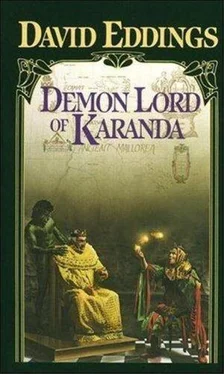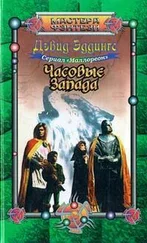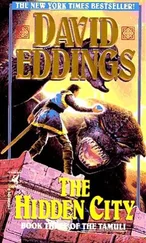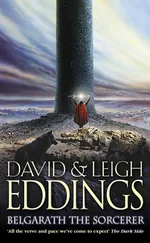David Eddings - Demon Lord of Karanda
Здесь есть возможность читать онлайн «David Eddings - Demon Lord of Karanda» весь текст электронной книги совершенно бесплатно (целиком полную версию без сокращений). В некоторых случаях можно слушать аудио, скачать через торрент в формате fb2 и присутствует краткое содержание. Жанр: Фэнтези, на английском языке. Описание произведения, (предисловие) а так же отзывы посетителей доступны на портале библиотеки ЛибКат.
- Название:Demon Lord of Karanda
- Автор:
- Жанр:
- Год:неизвестен
- ISBN:нет данных
- Рейтинг книги:3 / 5. Голосов: 1
-
Избранное:Добавить в избранное
- Отзывы:
-
Ваша оценка:
- 60
- 1
- 2
- 3
- 4
- 5
Demon Lord of Karanda: краткое содержание, описание и аннотация
Предлагаем к чтению аннотацию, описание, краткое содержание или предисловие (зависит от того, что написал сам автор книги «Demon Lord of Karanda»). Если вы не нашли необходимую информацию о книге — напишите в комментариях, мы постараемся отыскать её.
Demon Lord of Karanda — читать онлайн бесплатно полную книгу (весь текст) целиком
Ниже представлен текст книги, разбитый по страницам. Система сохранения места последней прочитанной страницы, позволяет с удобством читать онлайн бесплатно книгу «Demon Lord of Karanda», без необходимости каждый раз заново искать на чём Вы остановились. Поставьте закладку, и сможете в любой момент перейти на страницу, на которой закончили чтение.
Интервал:
Закладка:
David Eddings
Demon Lord of Karanda
Prologue
Being a brief history of Mallorea and the races that dwell there.
—Digested from The Chronicles of Angarak University of Melcene PressTradition places the ancestral home of the Angaraks somewhere off the south coast of present-day Dalasia. Then Torak, Dragon God of Angarak, used the power of the Stone, Cthrag Yaska, in what has come to be called “the cracking of the world.” The crust of the earth split, releasing liquid magma from below and letting the waters of the southern ocean in to form the Sea of the East.
This cataclysmic process continued for decades before the world gradually assumed its present form.
As a result of this upheaval, the Alorns and their allies were forced to retreat into the unexplored reaches of the western continent, while the Angaraks fled into the wilderness of Mallorea.
Torak had been maimed and disfigured by the Stone, which rebelled at the use to which the God put it, and the Grolim priests were demoralized. Thus leadership fell by default to the military; by the time the Grolims recovered, the military had established de facto rule of all Angarak. Lacking their former preeminence, the priests set up an opposing center of power at Mal Yaska, near the tip of the Karandese mountain range.
At this point, Torak roused himself to prevent the imminent civil war between priesthood and military rule. But he made no move against the military headquarters at Mal Zeth; instead, he marched to the extreme northwest of Mallorea Antiqua with a quarter of the Angarak people to build the Holy City of Cthol Mishrak. There he remained, so absorbed by efforts to gain control of Cthrag Yaska that he was oblivious to the fact that the people had largely turned from their previous preoccupation with theological matters. Those with him in Cthol Mishrak were mostly a hysterical fringe of fanatics under the rigid control of Torak’s three disciples, Zedar, Ctuchik, and Urvon. These three maintained the old forms in the society of Cthol Mishrak while the rest of Angarak changed.
When the continuing friction between the Church and military finally came to Torak’s attention, he summoned the military High Command and the Grolim Hierarchy to Cthol Mishrak and delivered his commands in terms that brooked no demur. Exempting only Mal Yaska and Mal Zeth, all towns and districts were to be ruled jointly by the military and priesthood. The subdued Hierarchy and High Command immediately settled their differences and returned to their separate enclaves. This enforced truce freed the generals to turn their attention to the other peoples living in Mallorea.
The origins of these people are lost in myth, but three races had predated the Angaraks on the continent: the Dalasians of the southwest; the Karands of the north; and the Melcenes of the East. It was to the Karands the military turned its efforts.
The Karands were a warlike race with little patience for cultural niceties. They lived in crude cities where hogs roamed freely in the muddy streets. Traditionally, they were related to the Morindim of the far north of Gar og Nadrak. Both races were given to the practice of demon worship.
At the beginning of the second millennium, roving bands of Karandese brigands had become a serious problem along the eastern frontier, and the Angarak army now moved out of Mal Zeth to the western fringes of the Karandese Kingdom of Pallia. The city of Rakand in southwestern Pallia was sacked and burned, and the inhabitants were taken captives.
At this point, one of the greatest decisions of Angarak history was made. While the Grolims prepared for an orgy of human sacrifice, the generals paused. They had no desire to occupy Pallia, and the difficulties of long-distance communication made the notion unattractive. To the generals, it seemed far better to keep Pallia as a subject kingdom and exact tribute, rather than to occupy a depopulated territory. The Grolims were outraged, but the generals were adamant. Ultimately, both sides agreed to take the matter before Torak for his decision.
Not surprisingly, Torak agreed with the High Command; if the Karands could be converted, he would nearly double the congregation of his Church as well as the size of his army for any future confrontation with the Kings of the West. “Any man who liveth in boundless Mallorea shall bow down and worship me,” he told his reluctant missionaries. And to insure their zeal, he sent Urvon to Mal Yaska to oversee the conversion of the Karands.
There Urvon established himself as temporal head of the Mallorean Church in pomp and luxury hitherto unknown to the ascetic Grolims.
The army moved against Katakor, Jenno, and Delchin, as well as Pallia. But the missionaries fared poorly as the Karandese magicians conjured up hordes of demons to defend their society. Urvon finally journeyed to Cthol Mishrak to consult with Torak. It is not clear what Torak did, but the Karandese magicians soon discovered that the spells previously used to control the demons were no longer effective. Any magician could now reach into the realms of darkness only at the peril of life and soul. The conquest of the Karands absorbed the attention of both military and priesthood for the next several centuries, but ultimately the resistance collapsed and Karanda became a subject nation, its peoples generally looked upon as inferiors.
When the army advanced down the Great River Magan against the Melcene Empire, however, it met a sophisticated and technologically superior people. In several disastrous battles, in which Melcene war chariots and elephant cavalry destroyed whole battalions, the Angaraks abandoned their efforts. The Angarak generals made overtures of peace. To their astonishment, the Melcenes quickly agreed to normalize relations and offered to trade horses, which the Angaraks previously lacked. They refused, however, even to discuss the sale of elephants.
The army then turned to Dalasia, which proved to be an easy conquest. The Dalasians were simple farmers and herdsmen with little skill for war. The Angaraks moved into Dalasia and established military protectorates during the next ten years. The priesthood seemed at first equally successful. The Dalasians meekly accepted the forms of Angarak worship. But they were a mystical people, and the Grolims soon discovered that the power of the witches, seers, and prophets remained unbroken. Moreover, copies of the infamous Mallorean Gospels still circulated in secret among the Dalasians.
In time, the Grolims might have succeeded in stamping out the secret Dalasian religion. But then a disaster occurred that was to change forever the complexion of Angarak life. Somehow, the legendary sorcerer Belgarath, accompanied by three Alorns, succeeded in evading all the security measures and came unobserved at night to steal Cthrag Yaska from the iron tower of Torak in the center of Cthol Mishrak. Although pursued, they managed to escape with the stolen Stone to the West.
In furious rage, Torak destroyed his city. Then he ordered that the Murgos, Thulls, and Nadraks be sent to the western borders of the Sea of the East. More than a million lives were lost in the crossing of the northern land bridge, and the society and culture of the Angaraks took long to recover.
Following the dispersal and the destruction of Cthol Mishrak, Torak became almost inaccessible, concentrating totally on various schemes to thwart the growing power of the Kingdoms of the West. The God’s neglect gave the military time to exploit fully its now virtually total control of Mallorea and the subject kingdoms.
For many centuries, the uneasy peace between Angaraks and Melcenes continued, broken occasionally only by little wars in which both sides avoided committing their full forces. The two nations eventually established the practice of each sending children of the leaders to be raised by leaders of the other side. This led to a fuller understanding by both, as well as to the growth of a body of cosmopolitan youths that eventually became the norm for the ruling class of the Mallorean Empire.
Читать дальшеИнтервал:
Закладка:
Похожие книги на «Demon Lord of Karanda»
Представляем Вашему вниманию похожие книги на «Demon Lord of Karanda» списком для выбора. Мы отобрали схожую по названию и смыслу литературу в надежде предоставить читателям больше вариантов отыскать новые, интересные, ещё непрочитанные произведения.
Обсуждение, отзывы о книге «Demon Lord of Karanda» и просто собственные мнения читателей. Оставьте ваши комментарии, напишите, что Вы думаете о произведении, его смысле или главных героях. Укажите что конкретно понравилось, а что нет, и почему Вы так считаете.












